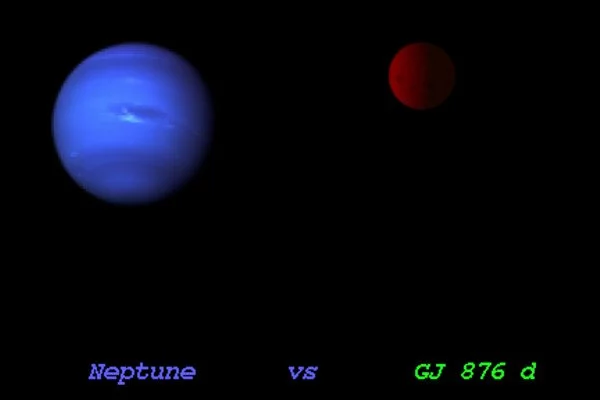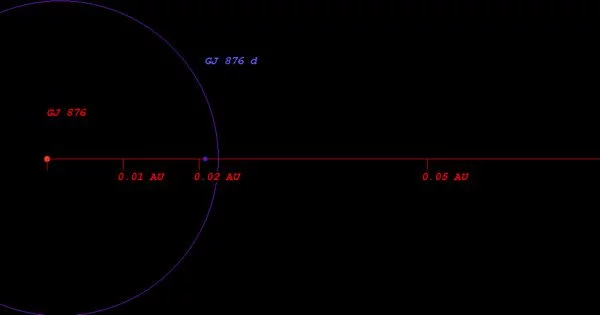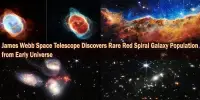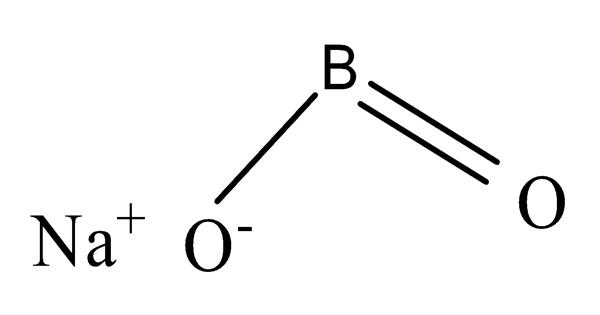Gliese 876 d is an exoplanet located around 15 light-years away in the Aquarius constellation. It is an exoplanet similar to Neptune that orbits a M-type star. The planet was discovered as the third planet orbiting the red star Gliese 876.
It has a mass of 6.83 Earths, takes 1.9 days to complete one orbit around its star, and is 0.020807 AU away from it. At the time of its discovery, it was the lowest-mass extrasolar planet aside from the pulsar planets circling PSR B1257+12. Because of its low mass, it is classified as a super-Earth. Its discovery was made public in 2005.
Mass
The mass of Gliese 876 d from radial velocity has one flaw: it can only be obtained as a lower limit. This is due to the fact that the observed mass value is also affected by the orbital inclination, which is generally unknown. Models involving gravitational interactions between the resonant outer planets, on the other hand, allow the inclination of the orbits to be computed. This shows that the outer planets are roughly coplanar, with an inclination of around 59° to the plane of the sky. If Gliese 876 d circles in the same plane as the other planets, its true mass is shown to be 6.83 times that of Earth.
The planet’s low mass has prompted speculation that it is a terrestrial planet. This type of huge terrestrial planet could emerge in the inner Gliese 876 system from material pushed towards the star by the inward migration of gas giants.

Radius
Alternatively, the planet could have formed further away from Gliese 876 as a gas giant and then migrated inward with the other gas giants. This would result in a composition that is higher in volatile components like water. The star would have blown off the planet’s hydrogen layer as it approached it through coronal mass ejection. In this idea, the planet would contain a pressurized ocean of water (in the form of a supercritical fluid) separated from the silicate core by a layer of ice preserved frozen by the planetary interior’s high pressures. An atmosphere including water vapor and free oxygen created by the breakdown of water by UV light would exist on such a planet.
Temperature
GJ 876 has an apparent magnitude of 10.2 and an absolute magnitude of 11.8. It is 0.3 times more massive and 0.4 times larger than our Sun. The surface temperature is 3350 degrees Fahrenheit, and the spectral type is M4 V. According to simulations, the radius of the exoplanet, depending on its mass, is likely to be roughly 1.65 REarth. Gliese 876 d’s equilibrium temperature is predicted to be around 614 K (341 °C; 646 °F).
Host star
The planet orbits a (M-type) star named Gliese 876. The star has a mass of 0.33 M☉ and a radius of around 0.36 R☉. It has a surface temperature of 3350 K and is 2.55 billion years old. In comparison, the Sun is about 4.6 billion years old and has a surface temperature of 5778 K.
Orbit
Gliese 876 d orbits the Sun at a semimajor axis of just 0.0208 AU (3.11 million km). Tidal interactions should theoretically circularize the orbit at this distance from the star; instead, observations show that it has a high eccentricity of 0.207, equivalent to Mercury in the Solar System.
According to models, if the planet’s non-Keplerian orbit could be averaged to a Keplerian eccentricity of 0.28, tidal heating would play a substantial role in its geology, even keeping it entirely molten. The predicted total heat flux at the planet’s surface is roughly 104–5 W/m2; by contrast, the surface heat flux for Io is approximately 3 W/m2.
Discovery
Gliese 876 d was identified by observing changes in the radial velocity of its star caused by the planet’s gravity. The Doppler shift in the star’s spectral lines was observed to determine the radial velocity. Gliese 876 was known to possess two extrasolar planets, dubbed Gliese 876 b and c, in a 2:1 orbital resonance at the time of discovery. After accounting for the two planets, the radial velocity still suggested a period of roughly two days. The planet, known as Gliese 876 d, was revealed on June 13, 2005 by a team led by Eugenio Rivera and was predicted to have a mass 7.5 times that of Earth.
















